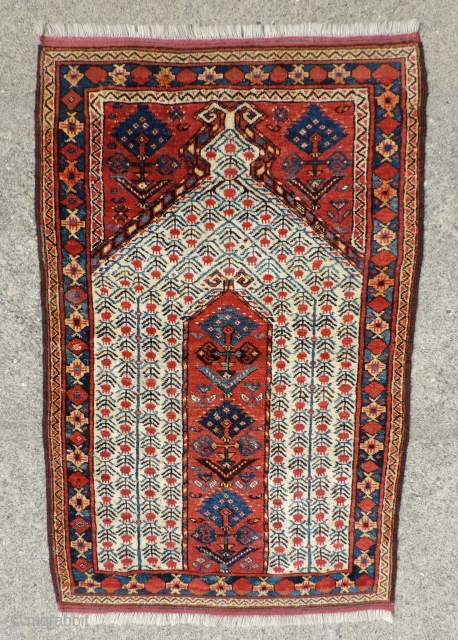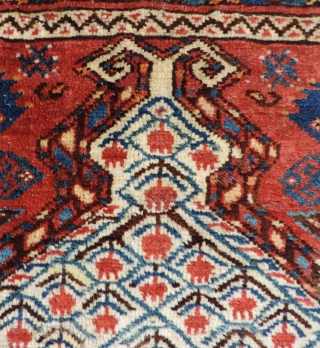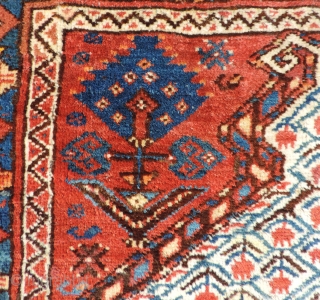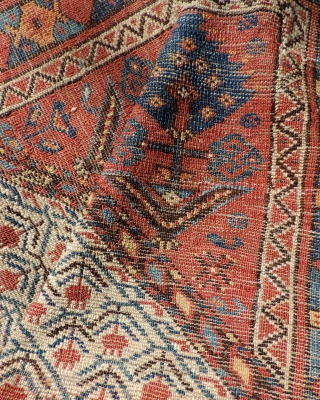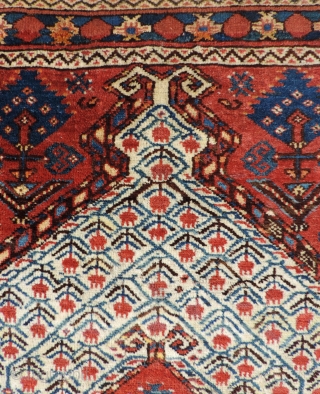Back
19th century Beshir prayer rug with a white ground mihrab that features clusters of stylized pomegranates. These prayer rugs are found in several different variants or groups as delineated by Ralph Kaffel some years back in Hali. Several early Turkmen carpet books featured these - thus lending an air of importance and prestige to the group that remains to this day. There is a bit of mystery as to the exact origins of these rugs, but it seems unlikely that they were made by Turkmen weavers as many believed. There is a small settlement in the Middle Amu Daria region known as Beshir, but it is not likely that these rugs were woven there. Considered quite rare in years past, there have now been enough of them published to dispel that myth. Though not exceedingly rare, they are hard to find and still retain a certain cache among collectors where they are much admired for their strong graphic quality and uniqueness among Central Asian carpets.
The piece does have repairs, but they are well done and not distracting to the eye. If you look closely at the full image you can make out the end reweaves. The ends were either worn off and tattered - or moths eaten - or nearly so, but despite this - the evidence indicates that the rug was not shortened in length (not cut and shut) - just rewoven to complete the picture. The sides have a redone selvedge of what looks like dark brown goat hair - but not too coarse. It looks authentic and was a good choice on the part of the restorer. Scattered throughout the piece are areas of re-knotting - not big sections and not re-weaves involving the foundation, but small areas of re-knotting. It’s hard to explain these other than to think that moths might have played a role in it all since otherwise the pile is pretty high for this kind of piece. There are also a couple of small areas along the border where there was a hole that required foundation work. All in all most of the work is around the outside of the piece which if it were stored for a long time could be explained by moths i suppose. i would say the restoration work overall improves rather than hurts the aesthetics and integrity of the rug.
price:
INQUIRE
- Home
- Antique Rugs by Region
- Category
- Profiles
- Post Items Free
- Albums
- Benaki Museum of Islamic Art
- Budapest: Ottoman Carpets
- Gulbenkian Museum
- Islamic Carpets. Brooklyn
- Islamic Textiles. Brooklyn
- Konya Museum: Rugs
- MKG, Hamburg
- MMA: Caucasian Carpets
- MMA: Mamluk Carpets
- MMA: Mughal Indian Carpets
- MMA: Ottoman Carpets
- MMA: Safavid Persian Carpets
- MMA: Turkmen Rugs
- McCoy Jones Kilims
- Ottoman textiles. Met
- Philadelphia Museum
- Rugs and Carpets: Berlin
- Seljuqs at the Met
- TIEM, Istanbul: Carpets
- V&A: Classical Carpets
- Vakiflar Carpets: Istanbul
- Baluch Rugs: Indianapolis
- Gallery Exhibitions
- Jaf an Exhibition
- Alberto Levi Gallery
- Andean Textile
- Christie's London: 2016
- Francesca Galloway
- HALI at 40
- ICOC Washington, DC 2018
- Jajims of the Shahsavan
- London Islamic Week April, 2018
- Mongolian Felts
- Navajo Rugs: JB Moore
- Persian Piled Weavings
- SF Tribal & Textile Art Show 2020
- SF Tribal 2019
- Sotheby's: C. Alexander
- Turkish Prayer Rugs
- Turkmen Main Carpets ICOC 2007










